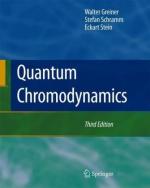|
This section contains 446 words (approx. 2 pages at 300 words per page) |

|
Quantum Chromodynamics, or QCD, is the theory describing the strong interactions between quarks and gluons. These interactions are responsible for binding quarks together into nucleons and mesons, and also for binding the nucleons together inside atomic nuclei.
QCD is quite similar in many respects to Quantum electrodynamics (QED). Instead of the positive and negative electric charges found in QED, QCD has three positive charges called colors. The names given to the colors vary, but a common scheme is red, green and blue. The negative charges usually are called anti-red, anti-green, and anti-blue. QED has one photon, a massless force-carrier particle, compared to QCD's eight massless force-carrier particles, the gluons.
The largest difference between QCD and QED lies in the group structure of the two theories. QED has a symmetry under an Abelian group called U(1), similar to the group of two-dimensional rotations. In an...
|
This section contains 446 words (approx. 2 pages at 300 words per page) |

|


